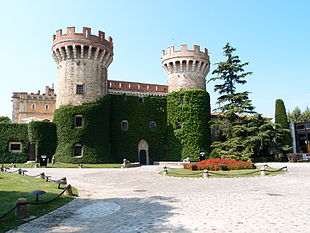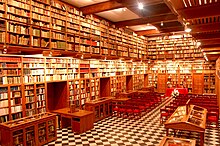Castell de Peralada
The Castell de Peralada is a completely walled historical ensemble in the Catalan municipality of Peralada , which is located in the province of Girona in northeastern Spain in the comarca of Alt Empordà . In addition to the former castle of the Counts of Peralada , which gives it its name, the total area of around 77,000 square meters includes a former medieval Carmelite monastery with an attached church, a historic landscape park from the 19th century and a modern auditorium for music festivals .
history
The origin of the Peralada Castle begins with the construction of a castle within the walls of the place by the Vice Counts of Peralada - those of Rocabertí - in the 9th century. This fortification was built in 1285 during the war against the French under King Philip III. completely destroyed. In the 14th century, the Rocabertís had the castell in Peralada rebuilt larger outside the original fortification walls; also in the 14th century the order of the Carmelites received permission to build a monastery and a monastery church adjacent to the new castle. After the monks left the monastery in 1835, it was taken over by the Rocabertís (since 1599 also Counts of Peralada) and used as a school. Around 1870 the last Counts of Peralada from the Rocabertís dynasty had their castle converted into a representative castle based on the French model, surrounded by a landscaped park that was laid out in 1877. When Tomàs de Rocabertí-Boixadors Dameto i de Verí (significant nobility titles: 12th Count of Peralada, 37th Vice Count of Rocabertí, 11th Count of Savallà , 10th Marquis d ' Anglesola and 10th Marquis of Bellpuig ) died in 1898 without descendants The building complex of the Castle of Peralada was temporarily empty and threatened to deteriorate, until 1923 the Catalan steel industrialist, banker, businessman and later mayor of Barcelona (1939–1945) Miquel Mateu i Pla (son of the banker and co-founder of the Hispano-Suiza company , Damià Mateu i Bisa ) acquired the entire ensemble, extensively and stylishly restored and expanded it. Since his death in 1972, the Castell de Peralada has been owned by his daughter Carmen Mateu Quintana , who in turn established the internationally renowned Peralada Music Festival on the grounds of the castle park from 1987 onwards. Since the death of Carmen Mateu in January 2018, her three children have run the Castell de Peralada Foundation together .
Juan Tomás de Rocaberti, Grand Inquisitor of Spain (1695–1699)
Monastery del Carme
The Gothic cloister of the monastery was built in the second half of the 14th century. Newer galleries were built around 1611/1612.
Monastery church del Carme
The 14th century Gothic church of El Carme was built as a single-nave church with side chapels between the buttresses. On the south wall of the nave there is a bell wall with two openings for the bells. The roof of the central nave in the form of a polychrome wooden ceiling is supported by five pointed arches. Carved heads representing the former monks' inhabitants are attached to the ends of the longitudinal beams of the ceiling. The floor tiles in the main nave are also worth mentioning. Four such tiles each form the coat of arms of the Count of Peralada. Belgian tapestries with motifs going back to Rubens hang in the chancel . The west facade has a rose window under which the Gothic main gate with a Virgin among the angels from the 15th century is located.
Park
The park of the Castells of Peralada extends over an area of 77,000 square meters, which in particular houses the historical buildings (castle, Carmelite monastery and monastery church). The Counts of Rocabertí combined their goal of having their historic military castle converted into a castle based on the French model, also with the desire to create a corresponding landscape park. The landscape architect François Duvilliers was chosen by the Rocabertís to design this park. Duvilliers took over the park design in 1877, but without ever having been to Peralada during his lifetime. According to the landscape architect's plans, the park comprised 33,800 square meters; the grounds of the Carmelite monastery were not included in this landscaping. Duvillier's plans provided for 158 different types of plants and trees; this number later proved to be exaggerated - after the park was designed - because the real space requirements of the plants were underestimated. The Count Rocabertí later added their own style elements to their landscaped park, which gave the ensemble its current appearance. The park now houses 63 design zones and is considered a historical park. Since May 2011 the palace park can be visited as part of a guided tour. On the initiative of the family who owned the castle, in 1996 - in cooperation with the director of the Parc Natural dels Aiguamolls de l'Empordà - a project to reintroduce white storks was successfully started; In 1998 the first stork was born in the castle park.
Todays use
Casino / restaurant
The casino is located in Peralada Castle and is an integral part of the so-called “Peralada Resort” complex, with the castle museums in the Convent del Carme , the Peralada winery, the Peralada Golf Club and its five-star hotel, wine spa and the International Peralada Music Festival. Attached to the casino is the Restaurant del Castell , which also has a terrace area above the landscape park and rooms in the two medieval twin towers of the castle.
Museums
The Museu del Castell de Peralada , offers the following museum sections: (1) the Biblioteca-Arxiu del Museu , the library of the museum, (2) the Museu del Vidre , the glass museum and (3) the Museu del Vi , the wine museum. The museums are managed and open to the public.
Library
The Biblioteca de Peralada ('Library of Peralada') was created in the middle of the 19th century by the Counts of Peralada, Antoni and subsequently his younger brother Tomàs de Rocabertí, in the former monastery building and contained around 20,000 books. In 1923 Miquel Mateu i Pla bought the entire ensemble of the Peralada Castle, including the already existing private library. By his death in 1972, Mr. Mateu expanded the collection to more than 80,000 volumes. Today, the private library covers topics from history, literature and art; it houses, among other things, important first editions, parchments and manuscripts. Miquel Mateu was a great admirer of Miguel de Cervantes and kept a collection of approximately 1,000 volumes of Don Quixote in his library, which were published in 33 languages. The private library in the former monastery of the Castells of Peralada is one of the largest in Catalonia and is open to the public from Monday to Friday as part of a museum tour.
Glass museum
The historical glass museum set up by Miquel Mateu i Pla in the Convent del Carme is one of the most important of its kind in Spain and one of the largest in Europe. Around 2,500 glass objects and 1,000 antique pottery items, especially from the 17th to 19th centuries, mainly from local Catalan production, are exhibited. This private collection of the Mateu family also includes archaeological finds of Greek and Roman origin from Empúries ; also ancient Egyptian, Syrian and Palestinian collectibles as well as antique perfume bottles from Spain, England, France and China. Glass objects from the 18th century from Bohemian factories are also among the exhibits in the Glass Museum.
Viticulture Museum
The monks of the Carmelite order had produced their own wine in the vaulted cellar of their monastery since the Middle Ages. When Miquel Mateu i Pla took over all the buildings including the historical landscape park, the monastery and the monastery church of the Castells of Peralada in 1923, he initially continued to make wine as a hobby at the historical site in the monastery cellar. After Mr. Mateu had decided to operate the wine and cava production on a commercial basis, the production was continued in the newly founded winery on an additional plot of land outside the monastery walls; only the "flagship" of all Peralada Cavas, the Gran Claustro , is still bottled and matured in the cellar of the Carmelite Monastery. From then on, Mr. Mateu used the vacant cellar rooms as a wine museum, in which he housed historical wine presses, goatskin wineskins and antique Catalan porrons , among other things . In a huge simulated wine barrel, Miquel Mateu i Pla established a room in which the wine tasting and other wine events held. Numerous 300 year old oak barrels are exhibited in another vaulted cellar. What is remarkable about these oak barrels are the barrel rings made of olive wood (instead of metal).
Festival Castell de Peralada
The Peralada Music Festival has been organized annually since 1987 by the Associació Cultural Castell de Peralada - under the direction of President Carmen Mateu de Suqué, under the direction of her three children since her death in January 2018 - in July and August on the grounds of the Castell performed by Peralada.
Cotton Club
The Cotton Club is connected to the casino within the castle grounds and offers the ambience for private and public celebrations as well as smaller music events with upscale bar and disco equipment.
Web links
- Museu del Castell de Peralada (Official Website)
- Convento del Carme de Peralada . In: monestirs.cat
- Convento del Carmen . In: artmedieval.net
- Museu del Castell de Peralada - Iglesia-Claustro (Official Website)
- Casino Castell de Peralada (Official Website)
- Festival Castell de Peralada (Official Website)
- Cotton Club - Casino Peralada (Official Website)
- Castillo Peralada (Official Wines and Cavas Website)
Individual evidence
- ↑ a b monestirs.cat: Convento del Carme de Peralada. Retrieved June 19, 2019 (Spanish).
- ↑ This paragraph is a brief summary of the description of the El Carme Church from the article Convent del Carme de Peralada on the Catalan language Wikipedia.
- ↑ Peralada Castle opens its gardens for viewing. In: comprendes.de
- ↑ REINTRODUCCIÓ DE LA CIGONYA BLANCA AL CASTELL PERALADA . In: castilloperelada.com ( Memento of the original from June 9, 2013 in the Internet Archive ) Info: The archive link was inserted automatically and has not yet been checked. Please check the original and archive link according to the instructions and then remove this notice.
Coordinates: 42 ° 18 ′ 27.2 ″ N , 3 ° 0 ′ 39 ″ E



























